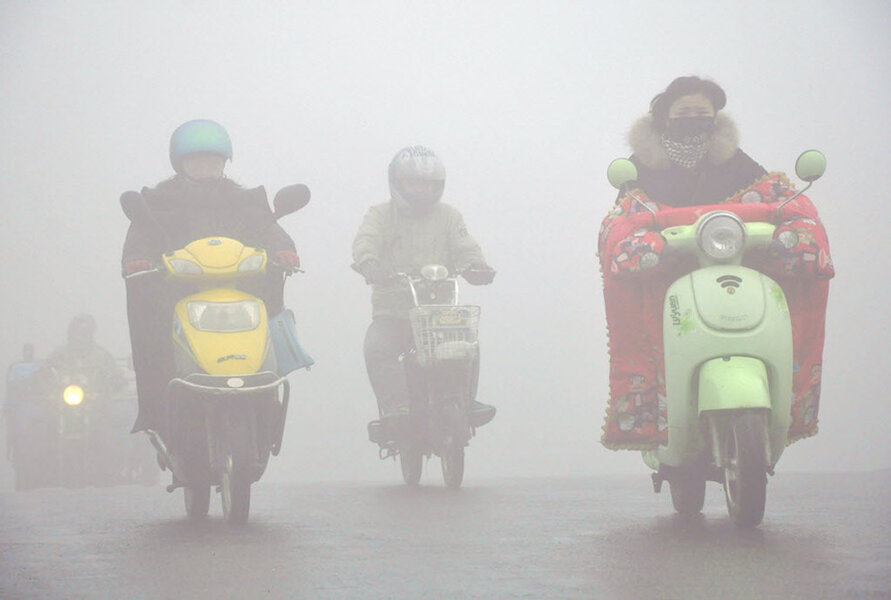Beijing's red smog alert: How other cities dealt with air quality disasters
Loading...
Beijing is under another “red alert” for smog, just two weeks after the government first sounded the top smog alarm in early December.
A red alert is issued when air pollution surpasses a level of 200 parts per million of fine particulates (referred to as PM2.5) for at least three days on a four-tier index that catalogs air pollutants. Beijing has struggled with dense smog for several years. The government adopted the colored alert system in October 2013 after photos of city residents wearing face masks and fighting their way through a dense blanket of smog made global headlines. Despite having passed the 200 mark numerous times, the Chinese government did not trigger the first red-alert warning until Dec. 7.
China's record on pollution has been under increased scrutiny in the months leading up to and during the United Nations' Climate Change Conference of the Parties. As the world's largest emissions producer, China has made considerable commitments to reducing it's carbon footprint, but many world leaders have remained skeptical that those pledges represent much more than empty promises. Some environmental experts see the red alerts as a signal that the country is ready to step up to address its pollution problem.
"That's a sign of a different attitude from the Beijing government," Dong Liansai, an energy and climate campaigner for Greenpeace, told Tech Times. "It shows they really want to initiate this alert system and deal with air pollution."
Beijing is not alone in facing cripplingly high pollution levels and attempting to address them. In London, the Great Smog of 1952, a thick, pollutant-laden fog that lasted for four days and killed approximately 4,000 people, prompted the passage of the Clean Air Acts of 1956 and 1968 aimed at reducing pollution. London still struggles with pollution, but has not seen a smog event of that magnitude since.
And over the past two decades, Mexico City has proved to be a model of environmental protection since the low ebbs of the early 1990s, creating environmental laws that have expanded the city’s public transportation system, among other provisions, as The Christian Science Monitor's contributor David Agren wrote in 2013:
Mexico City recorded only eight days with air quality considered "good" in 1992. That compares with 248 "good" air days in 2012, reflecting the success of initiatives to relocate industry, kick clunkers off the capital's streets, encourage cleaner technologies, and expand public transit and cycling options.
So far, Beijing has been largely focusing on immediate measures in response to acute spikes of pollutants.
The most recent red alert, which will last until midnight on Tuesday, prompted Beijing to remove half of its vehicles from the road, using an odd-even license plate system that will also be enforced in New Delhi starting next year. Outdoor construction has been banned, and factories and schools within the Beijing city limits are temporarily ordered to close.
Some Beijing residents questioned the new alert and the ensuing regulations, perhaps a sign of how accustomed to smog the people of Beijing have become.
"The smog is not so bad. Why do they have driving restrictions?" a Beijing resident posted Saturday on Weibo, China’s equivalent to Twitter.
Monitor writer Peter Ford, like all residents of Beijing has learned to live and work through thick gray air. But the implementation of the red alert, has prompted him and others in the city to think differently, as he wrote during the first red alert:
PM2.5 levels of 200 and above are by no means unusual in Beijing; we probably see that one day in five, depending on the season – winter months are the cruelest. I would not generally bother to wear a mask, unless I was riding my bike somewhere and breathing more deeply than normal.
But the red alert caught my attention today. I put my mask on just for the quick walk to the office. Some foreign correspondent colleagues were also jolted into unusual action – they let their staff work at home, which nobody had proposed a week ago when the pollution levels were much, much worse.
The red alert also prompted me to write this article, sending me on a search for new information that I have not included in any of the other stories I have written about pollution since I moved here nine years ago. I found one new scientific report from the Max Planck Institute suggesting earlier this year that 1.4 million people die prematurely in China every year from the effects of air pollution.
I’ll keep that mask on, I think. Or hold my breath for the next three days.






